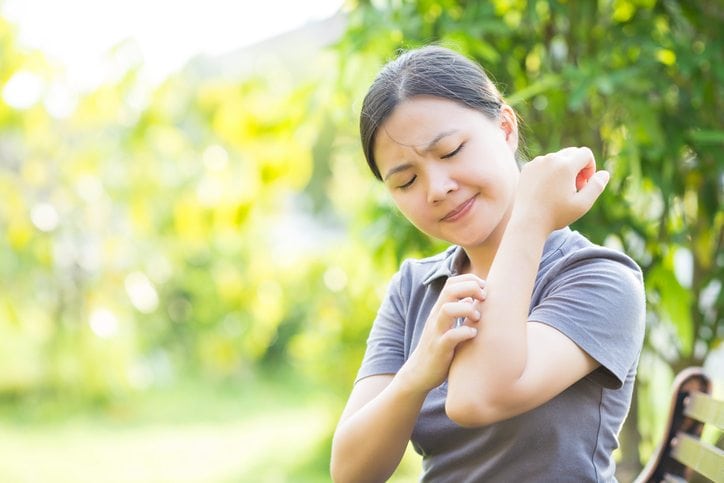You’ve applied insect repellent. You’ve avoided high, grassy areas. You’ve worn long pants tucked into your socks.
Yet you find yourself with an insect bite or sting that just plain annoying. Or worse, the kids are constantly scratching at bug bites on their arms and legs.
In most instances, bug bites and stings are treatable at home. Here are some pointers, courtesy of the U. S. Food & Drug Administration.:
What can be done for itching and pain from bites and stings?
Oral over-the-counter antihistamines can bring itch relief. Ibuprofen and acetaminophen can provide relief of pain from bites and stings.
In addition, there are many topical over-the-counter drugs that are applied to the skin and can provide itch and pain relief. Some of these topical OTC drugs are labeled as “external analgesics” or “topical analgesics.” They contain ingredients such as hydrocortisone, pramoxine, and lidocaine. There are also topical OTC drugs labeled as “skin protectants” that provide itch relief for insect bites and stings. These products contain ingredients such as colloidal oatmeal and sodium bicarbonate.
Keep kids’ nails short. If they scratch the area and break the skin, it can lead to a bacterial infection that will require treatment with antibiotics.
What’s the best way to remove a bee stinger?
It’s best to scrape a stinger away in a side-to-side motion with a straight-edged object like a credit card. Don’t use tweezers because it may push more venom into the skin. After removing a stinger, wash the area with soap and water. You can apply ice or another cold compress to help reduce swelling.
What should I do if I find a tick on me or my child?
Check for ticks after outdoor activities. If you find a tick, remove it with tweezers. Grasp the tick as close to the skin as possible and pull it straight out. Then drop it in a plastic bag, seal it up, and throw it away. Early removal of a tick is important to avoid transmission of tick-borne disease, including Lyme disease. After removing a tick, you can cleanse the area of the tick bite with antiseptic, such as rubbing alcohol or soap and water.
When is medical attention needed?
Seek medical attention in the event of any of the following:
- Signs of allergic reaction: Some people can experience anaphylaxis, a severe, life-threatening allergic reaction. This is a medical emergency that warrants calling 9-1-1 immediately. Signs of an allergic reaction, which may occur within seconds to minutes, include sneezing, wheezing, hives, nausea, vomiting, diarrhea, sudden anxiety, dizziness, difficulty breathing, chest tightness, and itching or swelling of the eyes, lips, or other areas of the face. If you or your child has ever had an allergic reaction to a sting or bite, you should be evaluated by an allergist. In some cases, you may be advised to wear a medical identification tag that states the allergy, and to carry epinephrine, a medication used to treat serious or life-threatening allergic reactions. Sometimes allergy shots may also be recommended.
- Symptoms of Lyme disease: Lyme disease, which is transmitted through the bite of an infected tick, can cause fever, headaches, fatigue, and a skin rash that looks like a circular red patch, or “bull’s-eye.” Left untreated, infection can spread to the joints, heart, and nervous system. It is rarely, if ever, fatal. Patients who are treated with antibiotics in the early stages of the infection usually recover rapidly and completely. Antibiotics commonly used for oral treatment include doxycycline, amoxicillin, or cefuroxime axetil (Ceftin). People with certain illnesses related to the heart or the nervous system require intravenous treatment with drugs such as ceftriaxone or penicillin.
- Symptoms of West Nile virus: West Nile virus, which is transmitted by infected mosquitoes, can produce flu-like symptoms including fever, headache, body aches, and skin rash. While most infected individuals have mild disease and recover spontaneously, infection can be serious or even fatal. There is no specific treatment for West Nile virus.
- Symptoms of Rocky Mountain spotted fever: Initial symptoms may include fever, nausea, vomiting, severe headache, muscle pain, and lack of appetite. The characteristic red, spotted rash of Rocky Mountain spotted fever is usually not seen until the sixth day or later after symptoms begin. But as many as 10 percent to 15 percent of patients may never develop a rash. Rocky Mountain spotted fever is treated with antibiotics.
- Signs of infection: It is normal for a bite or sting to result in redness of the affected area and minor swelling. But if a bite or sting becomes infected, a fever may develop or the redness or soreness may worsen. In cases of infection, an antibiotic is the typical treatment.
Need urgent care treatment for a sting or bite? Visit a Hartford HealthCare-GoHealth location near you.

